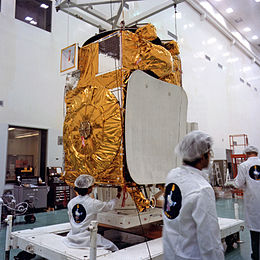|
INSAT-1D
INSAT-1D was 4th and the concluding multipurpose geostationary satellite of the INSAT-1 (first-generation seven-year responsibility for the operation of the INSAT space segment.[7] But the success of this launch meant a lot to India - a country that was setting up its national computer networks. Relying on a lot of communication circuits, microwave, coaxial, and fibre-optic telecommunication links throughout the country causes a huge problem; and thus the Indian Space Research Organisation (ISRO) planned at the start of the INSAT-1 series to always have at least two satellites in space to meet the increasing demand of telecommunication links for India's civilian community. INSAT-1A and INSAT-1C had already faced immature death and their plans had suffered a serious setback. Another satellite INSAT-1B, launched in 1983, exceeded its planned seven-year working life.[8] LaunchINSAT 1D was built by Ford Aerospace (now Loral Inc) for the Indian National Satellite System.[9] Initially, the launch was scheduled for 29 June 1989. Unfortunately, 10 days before that, during launch preparation, a launchpad hoist cable broke and a crane hook fell on it damaging its C-band reflector. The fully insured satellite was repaired by Ford Aerospace at a reported cost of $10 million. But that mishap was followed by solar panel damage of cost $150,000 suffered during the 1989 San Francisco earthquake. The satellite was finally launched from Launch Complex 17B, Cape Canaveral Space Force Station, United States with the Delta 2 rocket. It had a 7-year life expectancy.[2] StructureThe satellite was box-shaped, measuring 2.18 × 1.55 × 1.42 metres (7.2 × 5.1 × 4.7 ft).[2][1] A solar sail and 11.5-square-metre (124 sq ft) solar panel extended overall length to 19.4 m (64 ft) when deployed. It was housed 12 C-band transponders for telephone and data communications and two S-band transponders for direct broadcast service. A very high-resolution radiometer (VHRR) was installed for meteorological imagery for long-term weather forecasting, storm warning and resource management.[1] INSAT-1D played a vital role in replacing INSAT-1B. Moreover, at that moment India already had hired Arabsat's 12 transponders at high cost (the rate of $800,000 per transponder per year). Failure of the 1D mission would compel the government to hire more transponders.[8] See also
References
Second-generation the Second-generation the External links |
||||||||||||||||||||||||||||||||||||||||||||||||||||||||||||||||||||||||||||


